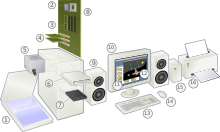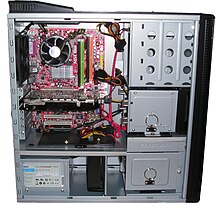COMPUTER HARDWERE
Computer hardware includes the physical parts of a computer, such as the case,[1] central processing unit (CPU), monitor, mouse, keyboard, computer data storage, graphics card, sound card, speakers and motherboard.[2]
By contrast, software is the set of instructions that can be stored and run by hardware. Hardware is so-termed because it is "hard" or rigid with respect to changes, whereas software is "soft" because it is easy to change.
Hardware is typically directed by the software to execute any command or instruction. A combination of hardware and software forms a usable computing system, although other systems exist with only hardware.
Von Neumann architecture[edit]
The template for all modern computers is the Von Neumann architecture, detailed in a 1945 paper by Hungarian mathematician John von Neumann. This describes a design architecture for an electronic digital computer with subdivisions of a processing unit consisting of an arithmetic logic unit and processor registers, a control unit containing an instruction register and program counter, a memory to store both data and instructions, external mass storage, and input and output mechanisms.[3] The meaning of the term has evolved to mean a stored-program computer in which an instruction fetch and a data operation cannot occur at the same time because they share a common bus. This is referred to as the Von Neumann bottleneck and often limits the performance of the system.[4]
Personal computer[edit]
The personal computer is one of the most common types of computer due to its versatility and relatively low price. Desktop personal computers have a monitor, a keyboard, a mouse, and a computer case. The computer case holds the motherboard, fixed or removable disk drives for data storage, the power supply, and may contain other peripheral devices such as modems or network interfaces. Some models of desktop computers integrated the monitor and keyboard into the same case as the processor and power supply. Separating the elements allows the user to arrange the components in a pleasing, comfortable array, at the cost of managing power and data cables between them.
Laptops are designed for portability but operate similarly to desktop PCs.[1] They may use lower-power or reduced size components, with lower performance than a similarly priced desktop computer. [5] Laptops contain the keyboard, display, and processor in one case. The monitor in the folding upper cover of the case can be closed for transportation, to protect the screen and keyboard. Instead of a mouse, laptops may have a touchpad or pointing stick.
Tablets are portable computer that uses a touch screen as the primary input device. Tablets generally weigh less and are smaller than laptops.
Some tablets include fold-out keyboards, or offer connections to separate external keyboards. Some models of laptop computers have a detachable keyboard, which allows the system to be configured as a touch-screen tablet. They are sometimes called "2-in-1 detachable laptops" or "tablet-laptop hybrids".[6]







